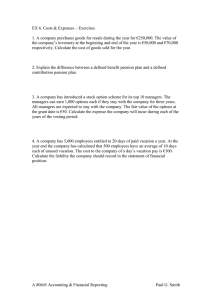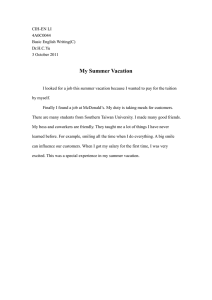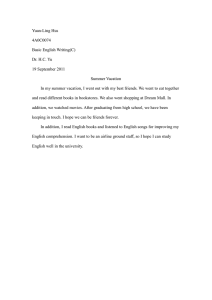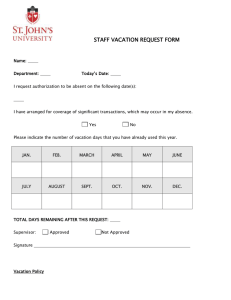Research Overview - Project: Time Off
advertisement
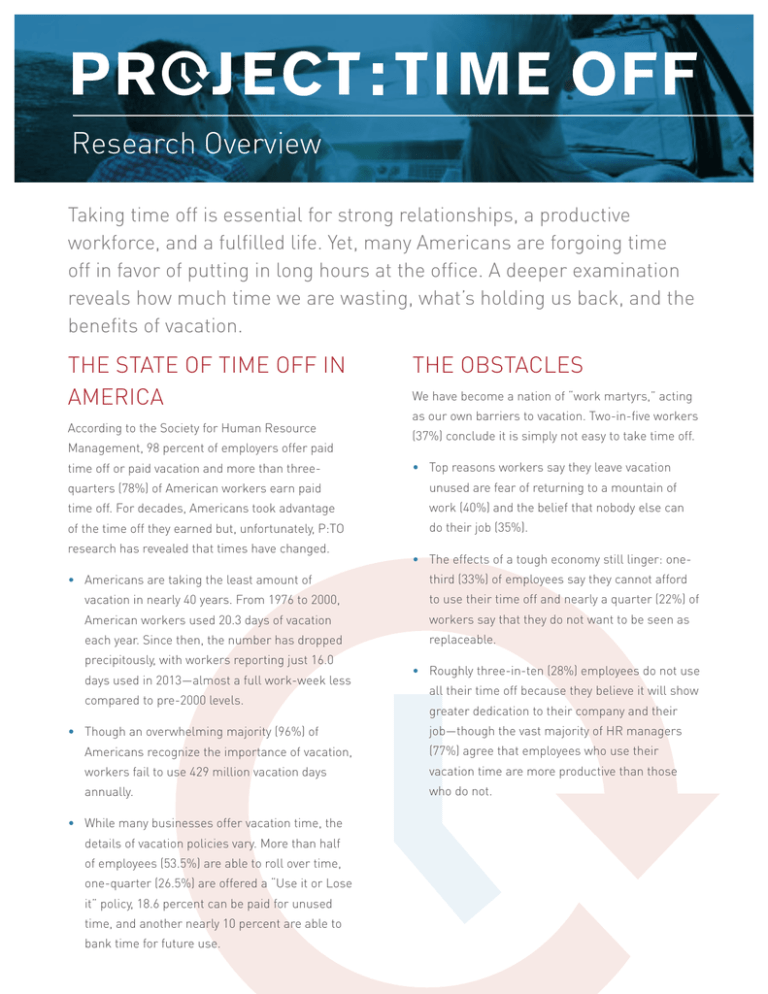
Research Overview Taking time off is essential for strong relationships, a productive workforce, and a fulfilled life. Yet, many Americans are forgoing time off in favor of putting in long hours at the office. A deeper examination reveals how much time we are wasting, what’s holding us back, and the benefits of vacation. THE STATE OF TIME OFF IN AMERICA According to the Society for Human Resource Management, 98 percent of employers offer paid time off or paid vacation and more than three- THE OBSTACLES We have become a nation of “work martyrs,” acting as our own barriers to vacation. Two-in-five workers (37%) conclude it is simply not easy to take time off. • Top reasons workers say they leave vacation quarters (78%) of American workers earn paid unused are fear of returning to a mountain of time off. For decades, Americans took advantage work (40%) and the belief that nobody else can of the time off they earned but, unfortunately, P:TO do their job (35%). research has revealed that times have changed. • Americans are taking the least amount of • The effects of a tough economy still linger: onethird (33%) of employees say they cannot afford vacation in nearly 40 years. From 1976 to 2000, to use their time off and nearly a quarter (22%) of American workers used 20.3 days of vacation workers say that they do not want to be seen as each year. Since then, the number has dropped replaceable. precipitously, with workers reporting just 16.0 days used in 2013—almost a full work-week less compared to pre-2000 levels. • Though an overwhelming majority (96%) of • Roughly three-in-ten (28%) employees do not use all their time off because they believe it will show greater dedication to their company and their job—though the vast majority of HR managers Americans recognize the importance of vacation, (77%) agree that employees who use their workers fail to use 429 million vacation days vacation time are more productive than those annually. who do not. • While many businesses offer vacation time, the details of vacation policies vary. More than half of employees (53.5%) are able to roll over time, one-quarter (26.5%) are offered a “Use it or Lose it” policy, 18.6 percent can be paid for unused time, and another nearly 10 percent are able to bank time for future use. America’s Always-on Work Culture Exerts a Powerful Influence. • Two-thirds of American workers (67%) say their company says nothing, sends mixed messages, or discourages using their time off. • Despite the fact that time off is part of employee compensation, nearly one-third of workers (31%) say they do not control their vacation time—the company does. Senior Leadership is Sending Mixed Messages to Employees. • One-third (33%) of senior business leaders state they never (19%) or rarely (14%) talk with • Nearly two-thirds (65%) of employees say their concentration and productivity improve with time off, and 61 percent report greater satisfaction at work. • Senior business leaders also agree that time off from work delivers benefits to their employees and companies: 91 percent believe employees return from vacation recharged and renewed— and ready to work more effectively. THE COST As work martyrs, Americans are leaving more time off unused each year, forfeiting their earned benefits and, in essence, working for free. employees about the benefits of taking time off, • The average American earns 21 days of time off despite the fact that 95 percent of them believe each year but uses only 77 percent of that time, it’s important. permanently forfeiting 4.9 days, a combined 169 • When taking time off, many senior business million days of earned time off. leaders have a hard time unplugging; only a third • The cost of forgoing time off totals $52 billion in (37%) can get away from work completely. Nearly forfeited benefits across the workforce. That’s half (46%) respond to emails and roughly three- more than the total wage and salary income of in-ten (29%) return work calls during vacation, several U.S. states, including Nevada, Arkansas, sending the signal that it is never okay to be Mississippi, and New Mexico. away from the job. • Employers carry unused vacation days as a THE BENEFITS liability on their balance sheets. This liability Despite reluctance to take time off, American billion in accumulated vacation time across the workers understand its benefits. private sector. • Most American workers believe time off helps them relax and recharge (90%), offers the opportunity to do what they enjoy (88%), and makes them happier (85%). • The majority of employees say that taking time off gives them the opportunity to engage in activities that they enjoy (88%) and strengthens bonds with their family and friends (79%). • Employees and managers alike believe time off steadily accrues, year after year, totaling $224 • Research Suggests No Link Between More Time at the Office and Getting a Raise or Bonus. • Employees who left 11-15 days off unused were actually less likely, by 6.5 percent, to have received a raise or bonus in the past three years than those who used all of their time off. • There is also a clear correlation between workers who have more unused vacation days and those who reported feeling “very” or is positive for mental (61% and 76%, respectively) “extremely” stressed at work, particularly for and physical health (55% and 67%, respectively). those employees who leave more than 11 days unused. THE OPPORTUNITY ABOUT PROJECT: TIME OFF The benefits of time off extend beyond the individual Project: Time Off is a research-driven initiative to employee or company. prove the personal, business, social, and economic • Using the 429 million days of time off would benefits that taking earned time off can deliver. deliver a $160 billion jolt to the U.S. economy, We aim to shift culture so that using personal time create 1.2 million new American jobs, and off is not considered frivolous, but essential to generate $21 billion in federal, state, and local strengthening relationships and improving personal revenues. health, a business investment with proven returns, • Encouraging workers to use just one more day and an economic necessity. each year would generate $73 billion annually for our economy. IT’S TIME FOR AMERICA TO TACKLE AND EXPERIENCE THE UPSIDE OF DOWNTIME. ProjectTimeOff.com@ ProjectTimeOff Info@ProjectTimeOff.com
